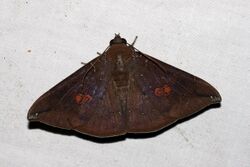Biology:Platyja umminia
| Platyja umminia | |
|---|---|

| |
| Scientific classification | |
| Domain: | Eukaryota |
| Kingdom: | Animalia |
| Phylum: | Arthropoda |
| Class: | Insecta |
| Order: | Lepidoptera |
| Superfamily: | Noctuoidea |
| Family: | Noctuidae |
| Genus: | Platyja |
| Species: | P. umminia
|
| Binomial name | |
| Platyja umminia (Cramer, [1780])
| |
| Synonyms | |
| |
Platyja umminia is a species of moth in the family Noctuidae first described by Pieter Cramer in 1780. It is found from the Indo-Australian tropics of China, Japan, India, Sri Lanka, Myanmar to New Guinea and Queensland. It is also present on Guam. Adults have been recorded piercing fruit in Thailand and Guam.[1][2]
Description
Its wingspan is about 48–60 mm. Male has bipectinate antennae with short branches. Mid and hindleg with tufts of very long hair from the femur-tibial joint. Body olivaceous red-brown. Forewings with a few grey specks. An antemedial obliquely waved dark line present. Orbicular small and dark. Reniform with dark outline. There is a postmedial crenulate line, highly excurved beyond the cell and then bent inwards to below middle of cell above two dark-edged marks, which in the female are filled in with ochreous, chestnut or white and with some chestnut rings or spots. A dark streak from apex, with some grey below it. Hindwings with crenulate postmedial line and traces of a sub-marginal line. Cilia tipped with white on both wings. Ventral sides with lines on discocellulars and a crenulate postmedial line with a white specks series on it.[3]
Adults and caterpillars are known to feed on soursop and other Annona species.[4][5]
References
- ↑ Holloway, Jeremy Daniel. "Platyja umminia Cramer". http://www.mothsofborneo.com/part-15-16/miscellaneous_i/miscellaneousi_4_1.php. Retrieved 16 August 2016.
- ↑ Herbison-Evans, Don; Crossley, Stella (3 March 2011). "Platyja umminia (Cramer, 1780)". http://lepidoptera.butterflyhouse.com.au/cato/umminia.html. Retrieved 22 January 2019.
- ↑ Hampson, G. F. (1894). The Fauna of British India, Including Ceylon and Burma: Moths Volume II. Taylor and Francis. https://www.biodiversitylibrary.org/item/180400#page/5/mode/1up.
- ↑ "Platyja umminia reared from caterpillar feeding on soursop". Insects of Guam. http://guaminsects.myspecies.info/platyja-umminia-reared-caterpillar-feeding-soursop. Retrieved 16 August 2016.
- ↑ "Fruit piercing moths in Micronesia and their natural enemies". Food and Agricultural Organization. http://agris.fao.org/agris-search/search.do?recordID=US9426605. Retrieved 16 August 2016.
External links
| Wikimedia Commons has media related to Platyja umminia. |
Wikidata ☰ Q10807454 entry
 |

